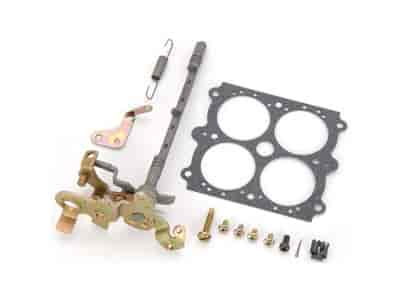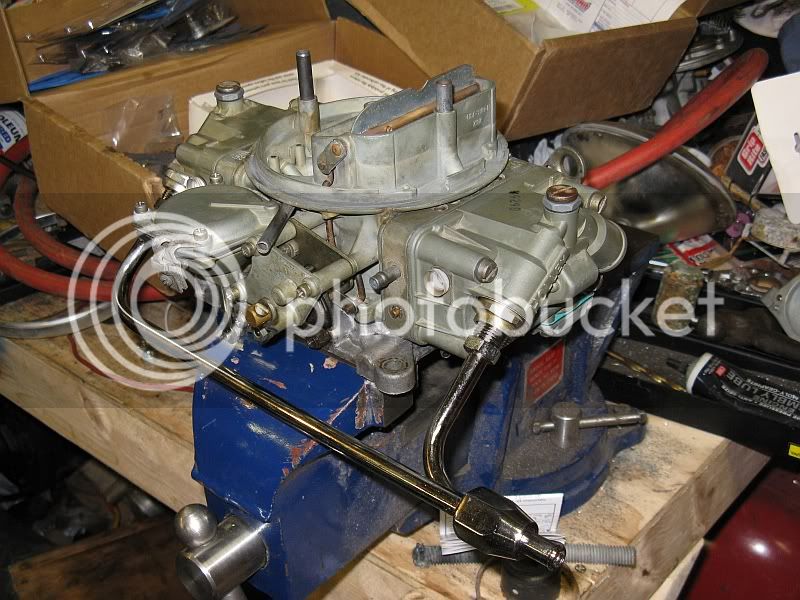I have a few comments about some of your questions, and also a few suggestions for you, and you may not agree with them.
1) Double-pumper and dual-feed are two entirely different things and one does not neccesarily have anything to do with the other. A "Double-Pumper" carb means that there are two accelerator pumps (power valves) on this carb, one within each of the two metering blocks situated on each end of the carb. This gives a dedicated pump to the primary venturiis, as well as a dedicated pump to the secondary set of venriis, all to ensure an adequate supply of fuel to all four venturiis (barrells) during hard acceleration.
In addition, all double-pumper carbs are mechanical-secondaries. There are NO Holley double-pumper carbs that have ever been made or sold that are double-pumpers with vacuum secondaries.
Now, Holley 4-barrel carbs with vacuum-secondaries don't use a metering block on both ends of the carb. There is a normal metering block on the primary end, but the other end (secondaries end) uses a metering PLATE instead of a metering BLOCK. There is no accelerator pump within the metering plate, just a simplified plate that feeds of of vacuum to operate the secondary jets, hence the "vacuum secondary" description.
"Dual-Feed" simply means there is a dedicated fuel line running to each end of the carb: One to the metering block, and one to the metering plate on a vacuum -secondary carb, and obviously one to each of the fuel blocks on a mechanical-secondary carb.
The prescence of a dual-feed set-up signifies nothing in regards to mechanical or vacuum secondaries.
Many unaware people over the years have paid big money for a Holley "Double Pumper" over the years when they were really buying nothing more thana simple dual-feed, vacuum secondary carb.
ALL Holley Double-Pumper carbs are 750 CFM or larger. They have never offered a smaller CFM double-pumper.
On a street-driven car, medium to light weight, a vacuum-secondary carb is a much better choice. It is far more responsive and easier to tune.
Some suggestions:
If this is a street driven car and you are looking for great performance, reliability and ease of use and maintenance, then I strongly suggest you consider getting an Edlebrock carb, which is basically a modern version of the legendary Carter AFB from years ago:
1) They are MUCH less expensive than a similar Holley
2) 95% of the time you can bolt one on right out of the box, and your car will run perfectly with no further adjustements.
3) With a one-piece body, there are NO GASKETS below the float-bowl which makes fuel-bowl leaks impossible. Holleys that sit without frequent use are famously prone to fuel-bowl leaks.
4) There is no power-valve set-up like Holleys, so it is impossible to have a "power valave blow-out" that happens to Holleys all the time. A single engine backjfire just one time will usually blow out a Holley power-vavle. Holley does use blowout-proof power valaves on carbs now, but oldr ones may not have been retro-fitted with one.
5) Fuel "jetting" can be done right on the car without removing the carb. Edlebrocks use "metering rods" instead of "fuel jets". Different methods to achieve the same thing.
In reality, a Holley carb is a far superior and infintely more adjutable device than an Edlebrock carb. For getting that last bit of avaialable performance out of your car, 10/10ths of its potential...there is no better carb. But only if you know intimately how to care and feed one. They take finesse and skill and reward you with astounding performance. Unfortunetaly, many who have Holleys on thier cars don't fully undertsand them and consequently get middling to poor performance from thier car without ever realizing how much performance they are truly missing.
On the other hand, and Edlebrock carb is simple, requires next to nothing in regular tuning and maintenance and delivers outstanding performance. Even the most novice of mechanics will get 90% of thier cars potential from an Edlebrock most often right out of the box.
If you want to simplify your life, drive your car instead of wrench on it all the time, and save a butload of money, get yourself an Edlebrock. You won't be sorry.
One piece of carb advice for all situations: LESS is MORE. A smaller carb will almost always perform better on the street than a larger one. For a street driven, near-stock 351 C in a 71-73 Mustang, a carb of 650-700 CFM will give much better off-the-line "zip", much quicker throttle repsonse and a little better fuel economy. The only thing you give up with a smaller carb is top-end performance, but if you don't plan to be at 4500-5500 rpm drag racing much, you are not losing a thing that is important.






